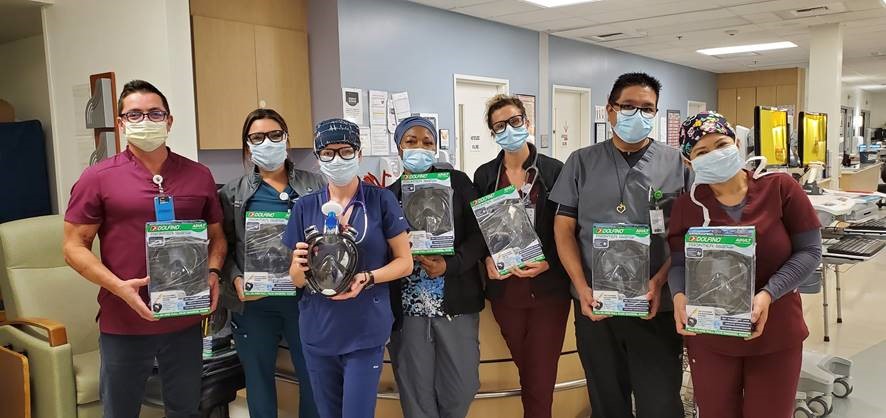As the demand for personal protective equipment (PPE) continues to skyrocket amid the COVID-19 crisis, businesses and nonprofit organizations have stepped up to help hospitals address critical supply needs.
The Pneumask™ face shield, and the team that developed the device, is a great example. In 38 days, a team of medical experts, clinicians and industry leaders came together to help address the shortage of PPE by turning a recreational snorkeling mask into a reusable face shield.
We spoke with two key leaders on the Pneumask project team, Dr. Gary Ansel, systems medical chief, Vascular Services with OhioHealth, and Paul Miller, vice president, R&D for Peripheral Interventions at Boston Scientific, about the collaborative process and what we can learn from this project as we move forward. Here’s what they had to say:
What is the Pneumask and how did you come up with the idea to use a full-face snorkel mask as a face shield?
Dr. Ansel: As the virus spread, I found myself constantly thinking about ways we could keep our healthcare workers safe. It felt like we needed to rethink what could be used as PPE. One day, my teenage son tossed out the idea of using snorkel masks, explaining, “a snorkel seals to the face, if you covered the air holes with air filters, it could work.” The idea was brilliant in its simplicity so I began pitching it to a few people, from industry professionals to potential suppliers, and everyone agreed that this could work.
The design we ended up using is relatively simple. It combines a full-face snorkeling mask and a custom-molded adapter that seals the opening and allows wearers to attach to a medical-grade air filter.
The project quickly evolved to include many different organizations, how did everyone come together?
Dr. Ansel: Boston Scientific was one of my first calls. I’ve worked with Boston Scientific for about a decade and have always admired how open-minded the team is to new ideas. I also recalled a tour of the labs in Minnesota and knew that Boston Scientific would be receptive to this out-of-the-box idea and have the capabilities to build the adapter. Most importantly, I knew that Boston Scientific would be willing to provide expertise and collaborate with others, which was critical in getting this done quickly. After speaking with Boston Scientific, I reached out to others in my network and learned that a consortium of medical experts, clinicians and industry leaders were developing a similar device. We put aside our competitive natures and joined forces.
The project evolved at an extraordinary pace, how was it possible to get this moving so quickly?
Dr. Ansel: It came down to everyone working together with a shared purpose to protect healthcare workers on the frontlines. We were in constant communication, pushing this project forward hour by hour. The team poured a lot of sweat equity into getting this completed. It was an impressive process to be a part of.
Miller: There was also an open-mindedness in the design phase that increased efficiency. For example, the original approach used 3D printing to create the adapters, but our Peripheral Interventions and Global Technology teams recognized that developing a soft steel mold for the Pneumask would increase manufacturing productivity, and everyone bought in. And by open-sourcing the design details for the custom mold, other companies continue to manufacture the adapters.
We are seeing incredible examples of collaboration in response to COVID-19. What lessons can we learn from the creation of Pneumask?
Dr. Ansel: This was a refreshing reminder of how much we can achieve when we operate more collaboratively, quickly and nimbly. Boston Scientific had a team convened in the hours after our initial conversation and testing and feasibility plans were underway over that weekend. When we learned that another group was working on a similar project, no one wasted time competing. Instead, we joined forces to create something that healthcare workers on the frontlines of the crisis need.
Miller: I agree, this was a great example of how collaboration with academics, clinicians and industry peers can turn new ideas into critically needed solutions. Everyone worked diligently, broke down barriers, and challenged conventional wisdom—a combination that allowed us to accomplish our goals in an unprecedented amount of time. This process also reinforced why we put patients and clinicians at the center of every innovation. This is a race against a devastating disease to save lives and playing a role in protecting front line healthcare providers is something I won’t forget.
On April 28, the first batch of over 1,500 Pneumask face shields shipped from our facilities in Maple Grove and Minnetonka. Thanks to the continued efforts of the consortium, over 23,000 Pneumask face shields have been deployed around the world.
To learn more about the Pneumask, please visit www.pneumask.org.
